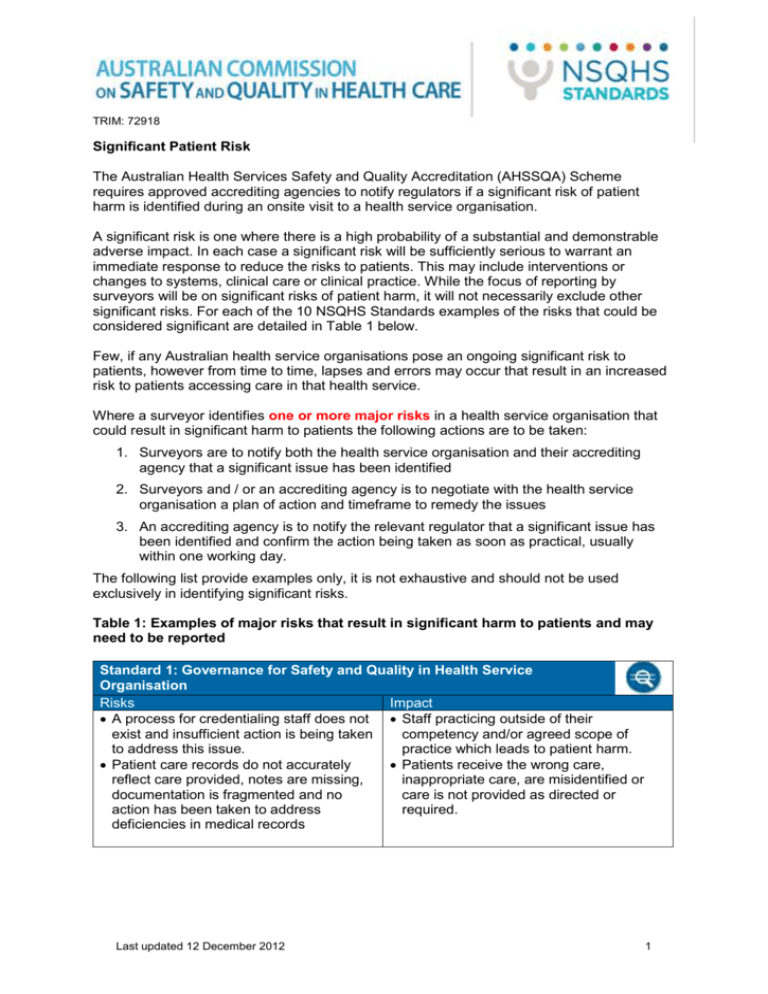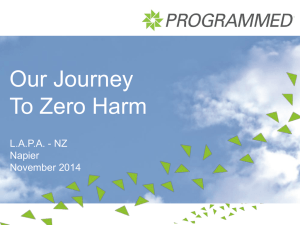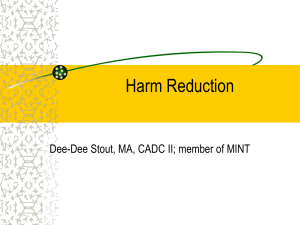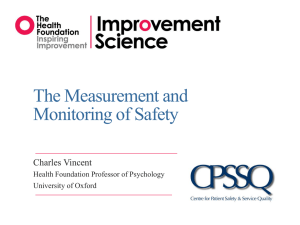Significant-patient
advertisement

TRIM: 72918 Significant Patient Risk The Australian Health Services Safety and Quality Accreditation (AHSSQA) Scheme requires approved accrediting agencies to notify regulators if a significant risk of patient harm is identified during an onsite visit to a health service organisation. A significant risk is one where there is a high probability of a substantial and demonstrable adverse impact. In each case a significant risk will be sufficiently serious to warrant an immediate response to reduce the risks to patients. This may include interventions or changes to systems, clinical care or clinical practice. While the focus of reporting by surveyors will be on significant risks of patient harm, it will not necessarily exclude other significant risks. For each of the 10 NSQHS Standards examples of the risks that could be considered significant are detailed in Table 1 below. Few, if any Australian health service organisations pose an ongoing significant risk to patients, however from time to time, lapses and errors may occur that result in an increased risk to patients accessing care in that health service. Where a surveyor identifies one or more major risks in a health service organisation that could result in significant harm to patients the following actions are to be taken: 1. Surveyors are to notify both the health service organisation and their accrediting agency that a significant issue has been identified 2. Surveyors and / or an accrediting agency is to negotiate with the health service organisation a plan of action and timeframe to remedy the issues 3. An accrediting agency is to notify the relevant regulator that a significant issue has been identified and confirm the action being taken as soon as practical, usually within one working day. The following list provide examples only, it is not exhaustive and should not be used exclusively in identifying significant risks. Table 1: Examples of major risks that result in significant harm to patients and may need to be reported Standard 1: Governance for Safety and Quality in Health Service Organisation Risks Impact A process for credentialing staff does not Staff practicing outside of their exist and insufficient action is being taken competency and/or agreed scope of to address this issue. practice which leads to patient harm. Patient care records do not accurately Patients receive the wrong care, reflect care provided, notes are missing, inappropriate care, are misidentified or documentation is fragmented and no care is not provided as directed or action has been taken to address required. deficiencies in medical records Last updated 12 December 2012 1 Standard 2: Partnering with Consumers No significant risks of direct patient harm Standard 3: Preventing & Controlling Healthcare Associated Infections Risks Hand hygiene is not evident across the organisation Single use invasive devices are being reused Multiple instances of aseptic technique is not being practiced in the health service Multiple instances of standard precautions and transmission based precautions are not being practiced in the health service Reusable medical devices are not decontaminated before reuse Impact Preventable infections are transmitted to patients. Standard 4: Medication Safety Risks A system to manage authorisations to prescribe, dispense and administer medications does not exist Patient medication histories are not taken or recorded in patients clinical records Adverse drug reactions are not recorded in patient clinical records or available at point of care Storage of medicines is unsafe or not secure. Impact Patients are given the wrong medication, do not receive the medication they require which leads to patient harm. Patients have adverse reactions to medicines which were preventable. Patient medicines can not be dispensed because they are not available, unsafe or ineffective resulting in harm. Standard 5: Patient Identification and Procedure Matching Risks Lack of an organisation-wide system for patient identification and procedure matching No evidence of action to address multiple near misses and/or incidents of mismatch between patients with their care Last updated 12 December 2012 Impact Patients are misidentified and experience preventable harm. 2 Standard 6: Clinical Handover Risks Lack of a structured clinical handover system by the health service No evidence of action or the action taken is insufficient to address multiple clinical handover failures that have resulted in serious patient harm Impact Patient information and/or accountability for care is not transferred and patients experience preventable harm. Standard 7: Blood and Blood Products Risks No evidence of action or insufficient action to address risks of serious patient harm from the delivery of blood or blood products Major adverse events related to blood and blood products are not recorded, reported or analysed Use, storage, collection and transportation of blood and blood product is unsafe Impact Blood or blood products are not available for patients requiring care. Preventable harm occurs to patients receiving blood or blood products. Unnecessary wastage of blood products reduces patient access to product, delaying care and or resulting in harm from contamination. Standard 8:Prevention and Management of Pressure Injuries Risks Failure to identify or monitor the risks of developing a pressure injury by the health service Skin inspections are infrequent or not undertaken on ‘at risk’ patients Impact Patients develop preventable pressure injuries. Standard 9: Recognising and Responding to Clinical Deterioration in Acute Health Care Risks Impact No evidence of action or insufficient Preventable patient harm occurs due to action to address multiple instances of undetected or managed deterioration. delayed or failed escalation and/or response to clinical deterioration Multiple instances of the clinical workforce without basic life support skills No access to clinicians with advanced life support skills for deteriorating patients Last updated 12 December 2012 3 Standard 10: Preventing Falls and Harm from Falls Risks Failure to identify or monitor patient falls and harm from falls by the health service No evidence of action or insufficient action to address multiple instances of falls prevention plans that are not developed or not applied Last updated 12 December 2012 Impact Patients are at risk of being injured from a preventable fall. 4









